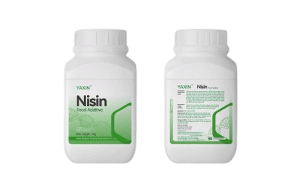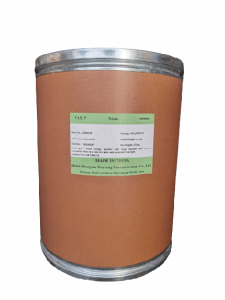Tel:+8618231198596

News
 CONTACT
CONTACT
 CONTACT
CONTACT
- Linkman:Linda Yao
- Tel: +8618231198596
- Email:linda.yao@dcpharma.cn
- Linkman:CHARLES.WANG
- Department:Overseas
- Tel: 0086 0311-85537378 0086 0311-85539701
News
Innovations in nisin production through fermentation technology.
TIME:2024-10-28
1. Genetic Engineering for Enhanced Strain Development
One of the most promising innovations in nisin production involves the genetic engineering of microbial strains to increase nisin yield. Scientists have developed genetically modified strains of Lactococcus lactis by manipulating genes involved in nisin biosynthesis. For instance, researchers can overexpress genes responsible for the production and regulation of nisin, resulting in higher peptide output. Additionally, scientists are experimenting with the deletion of repressor genes that limit nisin production, allowing for continuous and higher production rates. This genetic engineering approach not only increases productivity but also enhances the scalability of fermentation processes, reducing production costs and meeting rising market demand for nisin.
2. Optimizing Fermentation Conditions for Increased Yield
Another area of innovation lies in the optimization of fermentation conditions to maximize nisin output. Key parameters such as pH, temperature, oxygen levels, and nutrient composition have a significant impact on nisin production. Through advanced bioreactor design and control systems, researchers can closely monitor and adjust these conditions in real-time. For example, maintaining an acidic environment is favorable for nisin production, as it supports the growth of Lactococcus lactis and promotes peptide synthesis. Similarly, continuous monitoring and adjustment of oxygen levels during fermentation have been shown to improve yields. These refined fermentation conditions enable higher productivity while ensuring that production remains economically viable.
3. Utilizing Co-Culturing Techniques for Synergistic Production
In recent years, co-culturing techniques have emerged as an innovative approach to boost nisin production. By co-culturing Lactococcus lactis with other compatible microorganisms, researchers have found that nisin production can be enhanced due to synergistic interactions. For example, co-culturing with certain yeast strains can help modulate pH and oxygen levels, creating an environment that supports optimal nisin production. Additionally, some bacteria produce metabolites that stimulate Lactococcus lactis, encouraging it to produce more nisin. This approach, while still under investigation, holds potential for creating high-yield fermentation systems without the need for complex genetic modifications or expensive media components.
4. Developing Continuous Fermentation Systems
Traditional batch fermentation, although effective, is time-consuming and limited by the need to halt production between cycles. The development of continuous fermentation systems allows for uninterrupted nisin production, which significantly increases efficiency. In these systems, fresh media is continuously added to the bioreactor while the product is simultaneously harvested. This process maintains ideal conditions for nisin production, as microbial cultures are kept in a consistent growth phase, promoting steady output. Continuous fermentation systems also reduce labor and energy costs, making nisin production more economically and environmentally sustainable. This innovation is particularly useful for large-scale industrial applications, where consistent and high output is essential.
5. Enhancing Nisin Stability and Activity through Post-Production Modifications
Post-production modifications, including enzymatic treatments and encapsulation, are being explored to enhance nisin’s stability and bioactivity. Although nisin is naturally effective, it can lose its potency under certain conditions, such as high temperatures or exposure to extreme pH levels. By stabilizing nisin after fermentation, manufacturers can broaden its application in foods that undergo thermal processing or have longer shelf lives. For example, encapsulating nisin in liposomes or nanoparticles can protect it from degradation, allowing for gradual release over time. Additionally, enzymatic modifications that enhance nisin’s ability to resist degradation by proteolytic enzymes are under development. These post-production advancements expand the functionality of nisin, making it a versatile preservative for diverse food and pharmaceutical applications.
6. Renewable Substrates and Waste Valorization
The use of renewable substrates and waste valorization in fermentation media has garnered attention as a sustainable approach to nisin production. Traditional media components can be costly and have a significant environmental footprint. By using renewable substrates, such as agricultural by-products or food industry waste, fermentation processes can be made more cost-effective and eco-friendly. For instance, waste from sugarcane, corn, and potato processing can serve as nutrient-rich media, supporting microbial growth and nisin production. This practice not only reduces production costs but also minimizes waste, aligning with circular economy principles. Some fermentation facilities have already integrated waste valorization strategies, enhancing sustainability and economic efficiency in nisin production.
7. Artificial Intelligence (AI) and Machine Learning in Fermentation Optimization
The integration of artificial intelligence (AI) and machine learning is revolutionizing how fermentation processes are designed and optimized. By analyzing large datasets collected from fermentation experiments, AI algorithms can identify optimal conditions for nisin production more quickly than traditional methods. Machine learning models can predict how various factors—such as temperature, pH, and nutrient availability—affect nisin yield, allowing scientists to fine-tune the process with greater precision. AI-driven approaches have also been applied to predict the impact of genetic modifications on Lactococcus lactis, accelerating the development of high-yield strains. These innovations promise faster, more efficient nisin production with lower resource consumption and a reduced carbon footprint.
8. Bioprocessing Automation for Enhanced Production Efficiency
Automated bioprocessing systems equipped with real-time sensors and feedback loops enable precise control over fermentation processes, increasing the efficiency and reliability of nisin production. Automated bioreactors can maintain optimal conditions for Lactococcus lactis growth and nisin synthesis, minimizing the risk of contamination and reducing the need for manual intervention. This high level of control ensures consistent nisin quality and yield, making automation an attractive option for industrial-scale production. Additionally, automated systems can reduce labor costs, as they require minimal supervision and maintenance, further enhancing the cost-effectiveness of nisin production.
Conclusion
Innovations in fermentation technology have paved the way for significant advancements in nisin production, addressing both the industry’s demand for high yields and consumer expectations for natural preservatives. From genetic engineering and co-culturing techniques to AI-driven process optimization and renewable substrates, these cutting-edge methods enable more efficient, sustainable, and cost-effective production of nisin. As these technologies continue to evolve, nisin production is poised to become increasingly accessible and environmentally friendly, supporting the widespread use of this natural antimicrobial agent across various industries. These advancements not only meet the food industry’s current needs but also position nisin as a key player in the future of natural food preservation.
- Tel:+8618231198596
- Whatsapp:18231198596
- Chat With Skype







